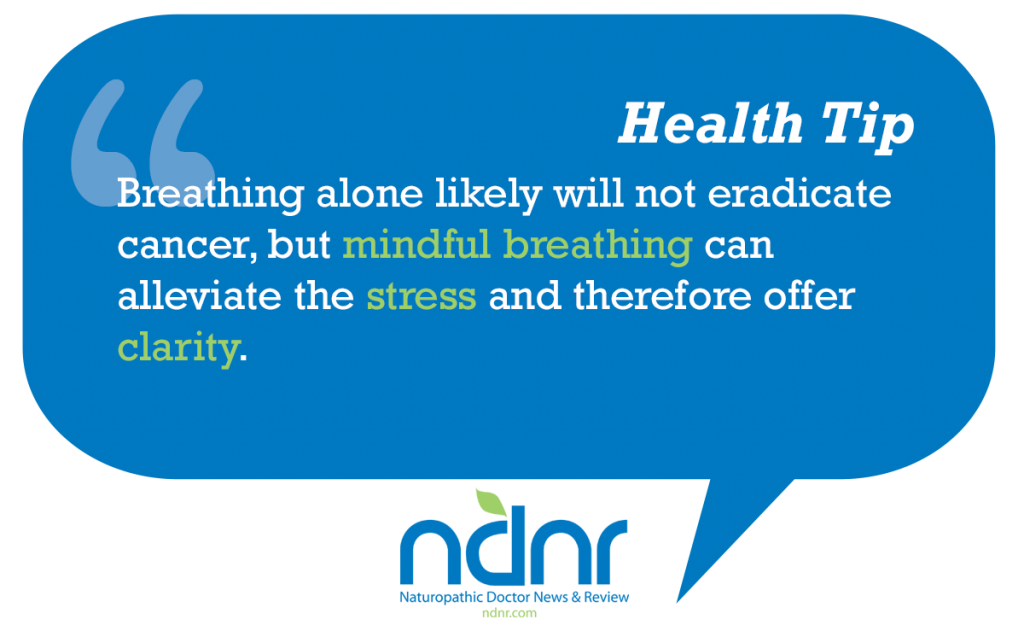Lena Suhaila, ND
Cancer is characterized by a loss of cellular control on the physical level; it follows that it is natural to experience a loss of control on the psychological level resulting in anxiety. Receiving a cancer diagnosis and needing to undergo cancer treatment prompts a high degree of emotional distress and can have negative implications for psychological health, can cause serious and or unpleasant side effects and may also adversely affect quality of life.1 For most patients, cancer means facing uncertainty, worries about cancer treatment effectiveness, fear of cancer progression and death, guilt, and spiritual questioning. This anxiety may be experienced in a variety of ways. A survey of 913 patients with cancer found that 94% experienced one or more of the following quality of life and psychological symptoms: fatigue (78%), anxiety (77%), depression (59%) and sleep disturbance (55%).2
Although anxiety is a common and normal reaction to cancer, if left untreated, anxiety may interfere with a patient’s quality of life and may even decrease a patient’s lifespan.3,4 How a patient copes with cancer is dependent upon several factors: how advanced their cancer is, the types of treatments they receive, how much support they have, and most importantly, the type of person they are and their conditioned response to stress. Also important is how the doctor has conveyed the diagnosis and the patient’s outlook on their outcome.
Sympathetic Nervous System Response
When faced with stress, the sympathetic nervous system becomes activated. Epinephrine speeds up the body’s functions causing the heart to beat faster, the muscles to contract, and the breath to become shallow. Shallow breathing causes a disruption in the balance of oxygen and carbon dioxide, resulting in a more acidic environment. As anyone who has engaged in anaerobic activity for long will attest to, buildup of acid in the body causes pain. Many of our patients believe that ‘tumors tend to exist and thrive in an acidic environment.’ Telling them that they need to breathe more deeply to prevent an internal acid milieu and possibly inhibit the cancer will make sense to them.5 Shallow breathing will also perpetuate the symptoms of anxiety.
Naturopathic medicine has the potential to alleviate the symptoms of cancer and side effects of conventional therapies while helping to augment the efficacy of these treatments. Naturopathic therapies also have positive effects on levels of distress and quality of life during treatment and rehabilitation.
Just as it is important to change the physical environment within the body, it is important to change the emotional environment. Mindfulness-based meditation practices offer a practical tool for making these changes.
Mindfulness-Based Stress Reduction
A method that we have found useful with our patients is a training program called Mindfulness-Based Stress Reduction (MBSR). This program was developed by Jon Kabat-Zinn at the Center for Mindfulness at the University of Massachusetts Medical Center in 1979 and is now offered at over 200 medical centers, hospitals, and clinics around the world. The Center tells us that the technique is, “… taught by physicians, nurses, social workers, and psychologists, as well as other health professionals who are seeking to reclaim and deepen some of the sacred reciprocity inherent in the doctor-caregiver/patient-client relationship. Their work is based on a need for an active partnership in a participatory medicine, one in which patients/clients take on significant responsibility for doing a certain kind of interior work in order to tap into their own deepest inner resources for learning, growing, healing, and transformation.”
The University of Massachusetts claims that over 18,000 people have gone through this training. Their directory lists over 500 certified practitioners. The program is a central feature in many hospital-based ‘integrative’ medical clinics. Because the MBSR program is systematized and so widely used in hospital settings, it has been widely studied. The program consists of 8 classes, during which meditation instruction is provided. The teaching includes various types of meditation in the form of a body scan meditation, hatha yoga postures, and sitting meditation.
The main feature of MBSR is the cultivation of mindfulness, a concept that has its roots in Buddhism. It consists of the development of a particular kind of attention, characterized by a nonjudgmental awareness, openness, curiosity and acceptance of internal and external present experiences, which allows practitioners to act more reflectively rather than impulsively.5
MBSR has the potential to be a valuable intervention for cancer patients to improve mood, sleep quality, and reduction in stress. MBSR teaches patients how to have a different response to the stresses in their environment.
MBSR has been shown in clinical research to have a profound effect on one’s ability to effectively regulate the mind, and consequently the emotions, and to a significant degree, physical health. One randomized controlled study with 91 patients heterogeneous in type and stage of cancer used an intervention consisting of a weekly meditation group lasting 1.5 hours for 7 weeks plus home meditation practice. Following completion of the study, patients in the treatment group had significantly lower scores on total mood disturbance and subscales of depression, anxiety, anger, and confusion, and more vigor than control subjects. The treatment group also had fewer overall symptoms of stress; fewer cardiopulmonary and gastrointestinal symptoms; less emotional irritability, depression, and cognitive disorganization; and fewer habitual patterns of stress. Overall reduction in Total Mood Disturbance was 65%, with a 31% reduction in symptoms of stress. This study demonstrated MBSR was effective in decreasing mood disturbance and stress symptoms in both male and female patients with a wide variety of cancer diagnoses, stages of illness, and ages.5,6
After surveying several hundred patients who had in prior years participated in an MBSR program, the majority reported that the single most important aspect they got out of the program was the mindful breathing.7
Observation of the Breath
Mindfulness is best described as moment-to-moment, non-judgmental awareness. The gateway of mindfulness is observation of the breath. Behavioral interventions such as deep breathing exercises have been shown to reduce anxiety levels and improve coping capability in stressful situations.7
Our breathing has the virtue of being a very convenient process to support ongoing awareness in our daily lives. From the moment we are born, until the moment we die, we breathe. The rhythm of our breathing varies considerably as a function of our activities and our feelings.
Breathing alone likely will not eradicate cancer, but mindful breathing can alleviate the stress and therefore offer clarity and a more balanced state of mind as well as support the natural healing process.
The Oncology Association of Naturopathic Physicians (OncANP) was founded in 2004 to enhance the quality of life of people living with cancer through both increasing the collaboration between NDs working with patients with cancer and integrating naturopathic practice into medical oncology care. With its co-organization, the American Board of Naturopathic Oncology (ABNO), the OncANP has set standards, instituted testing and now credentials Fellows in Naturopathic Oncology. The OncANP welcomes all NDs interested in improving their knowledge and ability to work with oncology patients. For more information visit www.OncANP.org.
Case Study
JM is a 56-year-old male with stage IV prostate cancer (Gleason score 9) with metastasis to the pelvis. He presented to the clinic with a markedly elevated PSA of 109.7 ng/mL. The PSA rose further to 149.6 ng/mL prior to a prostate biopsy. JM chose to eschew conventional treatment and to proceed solely with naturopathic treatment. His protocol included, but was not limited to, biweekly highdose IV vitamin C and a nutritional product sold over the internet. He made drastic dietary and lifestyle modifications. JM’s PSA dropped precipitously during the first month of treatment from 149.6 to 5.6 ng/mL. Over the course of the next 4 months, his PSA declined further to 0.4 ng/mL. As time went on, JM’s PSA began to rise again reaching 122 ng/mL over a short 2-month period.
As JM’s PSA rose, so did his anxiety. JM began to lose sleep and to have negative ruminating thoughts. We began to engage JM in biweekly breathing meditation exercises. At the end of each session, JM was notably calmer and expressed a deeper sense of well-being. Through the use of breathing exercises, we have been able to moderate JM’s experience of anxiety. He reports that the length of time he remains in an anxious state has greatly decreased.
Mindful Breathing Exercise
- Assume a comfortable posture lying on your back or sitting. If you are sitting, keep the spine straight and let your shoulders drop.
- Close your eyes if it feels comfortable.
- Bring your attention to your belly, feeling it rise or expand gently on the in-breath and fall or recede on the out-breath.
- Keep the focus on your breathing, “being with” each in-breath for its full duration and with each out-breath for its full duration, as if you were riding the waves of your own breathing.
- Every time you notice your mind has wandered off the breath, notice what it was that took you away and then gently and non-judgmentally bring your attention back to your belly and the feeling of the breath coming in and out.
- If your mind wanders away from the breath 1,000 times, then your “job” is simply to bring it back to the breath every time, no matter what it becomes preoccupied with.
Practice this exercise at a convenient time for 15 minutes every day, whether you like it or not, for 1 week and see how it feels to incorporate a disciplined meditation practice into your life. Be aware of how it feels to spend some time each day just being with your breath without having to do anything.
 Lena Suhaila, ND earned her doctorate degree in naturopathic medicine from the National College of Natural
Lena Suhaila, ND earned her doctorate degree in naturopathic medicine from the National College of Natural
Medicine. She focuses on promoting optimal health and overcoming chronic disease. Dr. Suhaila emphasizes that physical, emotional and spiritual aspects of imbalance must be addressed in order to restore optimal health. Before studying naturopathic medicine, she did molecular research on prostate cancer and worked on the development of drugs for autoimmune conditions. Dr. Suhaila loves practicing medicine and is wholeheartedly dedicated to helping people work towards a higher level of wellness.
References
1. Zabora JR, Smith-Wilson R, Fetting JH, Enterline JP. An efficient method for psychosocial screening of cancer patients. Psychosomatics. 1990;31(2):192-196.
2. Ashbury FD, Findlay H, Reynolds B, McKerracher K. A Canadian survey of cancer patients’ experiences: are their needs being met? J Pain Symptom Manage. 1998;16(5):298-306.
3. Epel ES, Blackburn EH, Lin J, et al. Accelerated telomere shortening in response to life stress. Proc Natl Acad Sci U S A. 2004;101(49):17312-17315.
4. Epel ES. Psychological and metabolic stress: a recipe for accelerated cellular aging? Hormones. 2009;8(1):7-22.
5. Kabat-Zinn J. An outpatient program in behavioral medicine for chronic pain patients based on the practice of mindfulness meditation: theoretical considerations and preliminary results. Gen Hosp Psychiatry. 1982;4(1):33-47.
6. Speca M, Carlson LE, Goodey E, Angen M. A randomized, wait-list controlled clinical trial: the effect of a mindfulness meditation-based stress reduction program on mood and symptoms of stress in cancer outpatients. Psychosom Med. 2000;62(5):613-622.
7. Kabat-Zinn J. Full Catastrophe Living: Using the Wisdom of Your Body and Mind to Face Stress, Pain, and Illness. New York, NY: Delacorte Press; 1990.





